What Tempture Should You Fill Your Bird Feeds in Fallwinter North
When the chill of winter sets in on your yard, you may begin to worry about the birds struggling to survive the cold. They don't have the luxury of blankets, cozy fireplaces or even a cup of hot chocolate to help them stay warm.
But what they do have is you! As a bird feeding fan, you can help birds not only survive, but thrive during the coldest stretches of winter. By providing them with food, water, and even shelter, you can make a difference and help them thrive!
How Do Birds Survive the Winter?
As a person who feeds birds in the winter, it's good to understand how birds cope with frigid temperatures. In fact, we humans need to remember that birds were made to survive the winter, and many can carry on through such weather without much help from humans.
Feathers
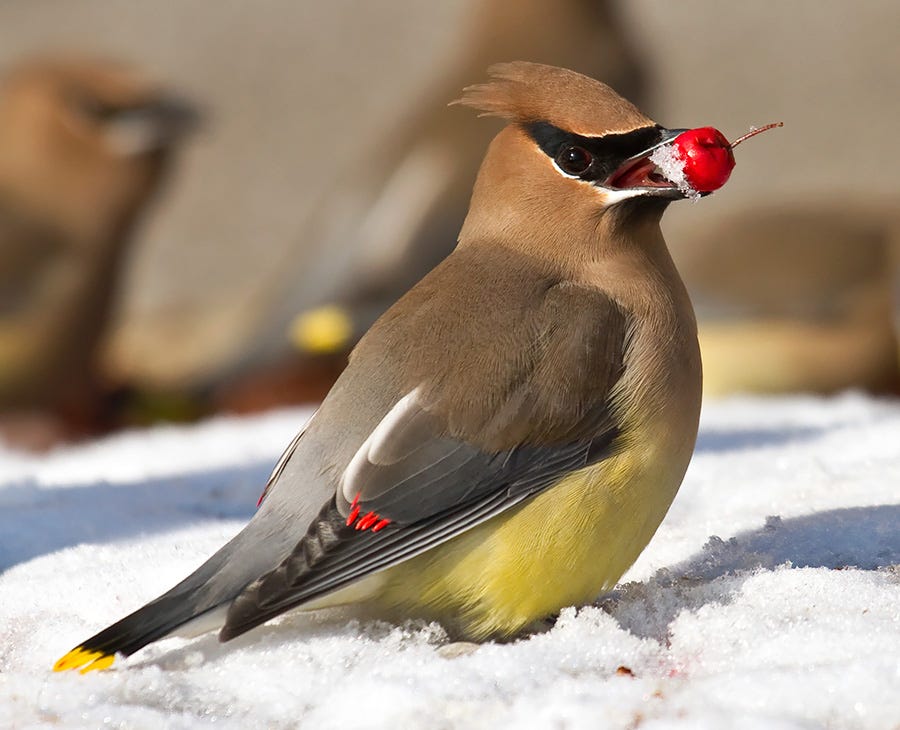 Birds have a built-in winter coat thanks to their layered plumage. Feathers overlap extensively, which helps them keep heat close to their bodies. Even flying through the air, they stay quite warm.
Birds have a built-in winter coat thanks to their layered plumage. Feathers overlap extensively, which helps them keep heat close to their bodies. Even flying through the air, they stay quite warm.
If they do need to warm up, birds have learned to expose their backs to the sun and fluff up their feathers. Why their backs? This region has a large surface area and birds have learned to use their backs as a personal solar heater! When they're warm enough, they flatten their feathers to the normal position and that heat is further trapped in their insulating feathers.
Feet
Another adaptation is that their exposed feet do not get cold very easily. Unlike humans, our feathered friends have a fine network of arteries and veins that run through their exposed skin. Their blood circulates into those areas and keeps them from getting cold.
Beyond that amazing internal plumbing, the scales on bird feet and legs also minimize heat loss.
Flight
The ability to fly is another huge advantage in the winter. This mobility helps birds find food and water relatively fast when compared to land-based animals.
Likewise, birds are less likely to be exposed to severe weather because they can escape it quickly. That means birds don't face the same exposure risks we do – they rarely get wet in freezing weather! (Sure, ducks and other water birds get wet, but they have even better insulation than your typical songbird!)
Attracting Birds in Winter
If it's important to make your yard an inviting place for birds in the spring and summer, then winter birdscaping is absolutely vital! By doing so, you'll be guaranteed regular visits from a variety of birds – something that will help break up the monotony of a dreary season.
Natural Cover for Birds
One of the best ways to guarantee regular appearances by backyard birds is to provide them with natural cover throughout the winter. Evergreen shrubs and coniferous trees are great shelters for birds during harsh winter weather. This vegetation protects birds from the wind, predators, and precipitation.
Another option is to create a brush pile that birds can use for roosting. Even this seemingly sparse protection provides them with a safe place to rest and works as a hiding place from predators.
Winter Bird Houses
Very few birds raise young during the winter, so you might think that your birdhouses go unused during the cold season. Not so! You'll find many birdhouses occupied on cold winter nights, often by chickadees and other cavity nesters.
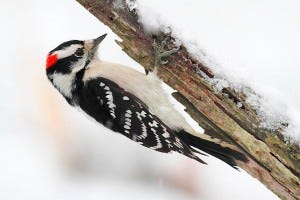 Of course, birdhouses aren't the perfect winter getaway. They are made to draw in the air from outside – a design meant to cool young birds during hot summers.
Of course, birdhouses aren't the perfect winter getaway. They are made to draw in the air from outside – a design meant to cool young birds during hot summers.
You can make birdhouses a little better by adding some insulating material, such as wood chips or bits of fabric, early in the fall. Just make sure you clean it out in the early spring!
Some birdhouses, however, are designed to convert for winter use! These houses have a front wall that can be removed and rotated for winter use. By putting the entrance hole at the bottom of the feeder, it traps more heat for its winter users.
Winter Bird Nesting
We mentioned above that very few birds will rear young in the winter, that means they don't really make nests either! Nests are only used to keep eggs and young protected.
When people say a bird is "nesting overnight," they really should be saying that a bird is "roosting" for the night!
In the winter, birds prefer to roost in a sheltered spot that keeps them safe from predators while protecting them from wind and precipitation. Ideal roosting spots include inside old or unused buildings, inside evergreen trees and shrubs, on tree branches, in dense brush or in shelter provided by tree cavities or other natural resources.
Other birds will simply gather together on a branch or wire, using their collective body heat to add to their warmth.
You can help birds survive long winter nights by providing the shelter types above. You can also create a roosting pocket, a woven shelter that retains heat better than a birdhouse. You can hang it just like a birdhouse.
Best Winter Bird Feeders
When you select a bird feeder for winter feeding, you should make a number of considerations to accommodate for the birds you're feeding and provide protection from the weather. The features you should look for are:
-
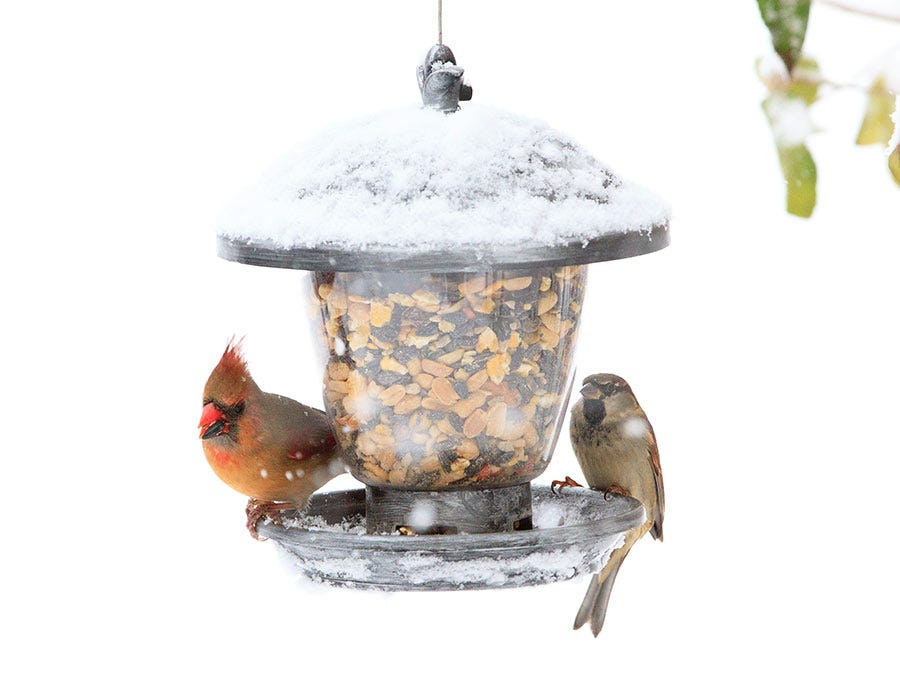 Wide lids – Bird feeders with a wide lid are great for winter bird feeding. The lid helps to shield seeds from being exposed to rain, ice, and sleet. The lid will also keep snow from accumulating on feeder trays. Large, overhanging lids also help your birds, too. A large feeder lid can provide a buffer from harsh weather and allow birds to further retain body heat.
Wide lids – Bird feeders with a wide lid are great for winter bird feeding. The lid helps to shield seeds from being exposed to rain, ice, and sleet. The lid will also keep snow from accumulating on feeder trays. Large, overhanging lids also help your birds, too. A large feeder lid can provide a buffer from harsh weather and allow birds to further retain body heat. - Moisture control features – Some bird feeders, including our all-metal mesh feeders, expose seeds to the elements. This is actually OK. The seeds may get drenched by rain or sleet, but they'll dry off very quickly since they're exposed to the air. What you don't want is a bird feeder that offers no way for the moisture to evaporate or drain from it. The best winter bird feeders will have drain holes in the feeding tray and hopper.
- Feeding styles – Be aware that different species feed in different ways. Some birds, such as Northern Cardinals, prefer to feed from trays. Others, including the White-breasted Nuthatch, like to climb on a feeder and pluck out seeds. You may also want to consider feeders that only allow small birds, such as Black-capped Chickadees, to eat from them. Better yet, get a feeder to accommodate every type of bird!
- Squirrel proofing – Squirrels are active all year long, so you'll need to protect your bird seed from them. Your feeder should include at least one or two anti-squirrel features, such as all-metal construction or a weight-activated shutoff. Another option is to provide a feeder that squirrels can access easily and fill it with the foods they love. This may keep them away from your favorite birds-only feeders.
- Easy to remove – At least once every two weeks, you need to take your bird feeders down and clean them with warm, soapy water. That means you need a feeder that's easy to remove from its hanging hook, line or pole. In the dead of winter, you don't want to be outside working with a bunch of tools just to remove your feeder!
Water for Birds in the Winter
Another great way to help birds in the winter is by providing them with fresh, unfrozen water. While thirsty birds will eat snow, it's an energy drain as they have to waste valuable body heat to unthaw it.
As a backyard bird enthusiast, you can help them conserve that energy for more important things. All you need to do is provide your birds with a supply of fresh water. Do that with a birdbath or bird waterer.
Of course, if the outdoor temperatures are below freezing, you'll have to take steps to keep the water ice-free. For birdbaths, try placing an oven-heated brick in the water – one brick in the morning should be enough. For bird waterers, take them inside at night to unthaw and put them back out in the morning.
If you're worried about your birds getting wet in your bird bath and freezing to death, don't fret too much. Their instincts will let them know when to take a bath in the winter and how to dry off afterward.
Winter Bird Feeding
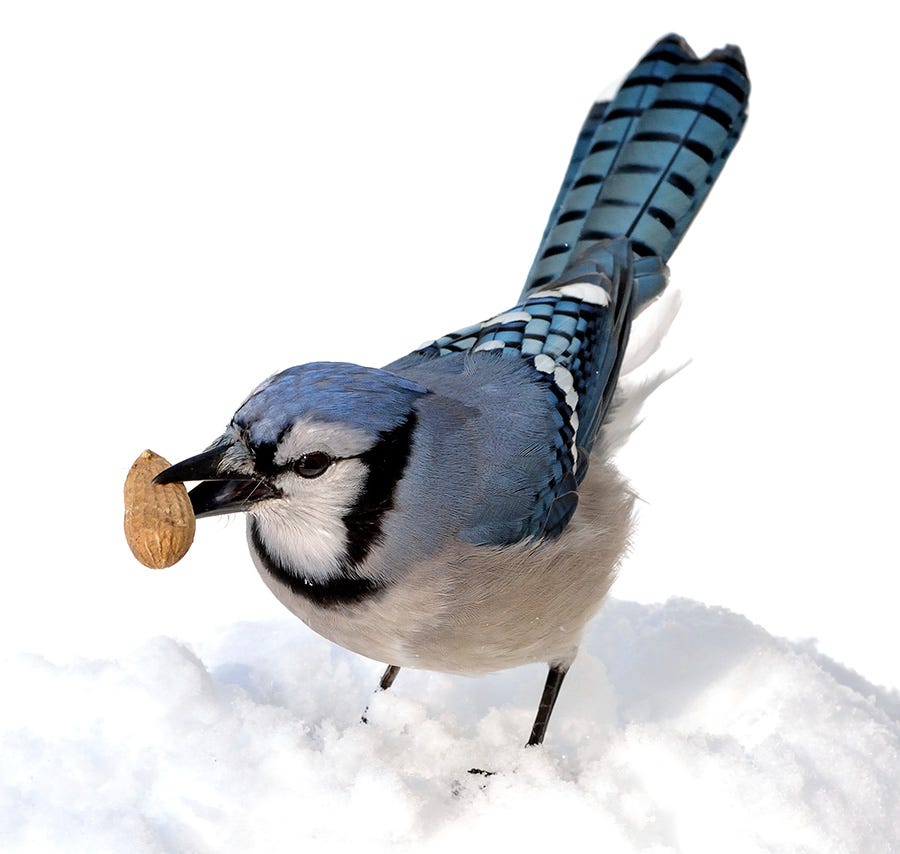 In the late fall and winter, heavy snowfalls can quickly bury natural sources of wild bird food. In addition, most of the lush berry- and seed-laden vegetation of spring and summer has withered and blown away, and most insect species are either dead or dormant.
In the late fall and winter, heavy snowfalls can quickly bury natural sources of wild bird food. In addition, most of the lush berry- and seed-laden vegetation of spring and summer has withered and blown away, and most insect species are either dead or dormant.
It's during this time that many birds begin to rely on the seed feeders found in backyards across North America. Thanks to our kindness, a few bird species have actually changed their naturally occurring ranges – often staying farther north in the U.S. and Canada than they did 100 years ago.
Those birds, along with the birds that don't migrate south for the winter, are happy to indulge in the bird seed you offer them throughout the coldest months of the year.
What bird seed should you offer birds in the winter? There are several options:
- Black-oil Sunflower Seed – Easily the best, all-around bird seed, black-oil sunflower seed will draw in a huge variety of species thanks to the fact that it's packed with protein. Big birds and small birds alike love this seed!
- Safflower Seed – If you're having trouble with squirrels raiding your feeders, then safflower seed is a great option. Squirrels don't like to eat this seed, but birds don't seem to mind. Among others, you can expect to see Northern Cardinals, grosbeaks and chickadees at a feeder filled with safflower seed.
- Peanuts – Another high-protein option for bird feeders are in-the-shell peanuts or peanut pieces. Birds absolutely love peanuts, but so do many other animals! Still, there's no denying that a steady supply of peanuts will be a big boost to your birds through a tough winter.
- Nyjer® Seed – Another anti-squirrel option is Nyjer® seed, which most varieties of finch will happily gobble up. This tiny, slender seed requires a specialized finch feeder to hold it.
- Species-specific mixes – The birdseed company Lyric® has created a variety of special blends that are meant to attract specific species or groups of birds. These mixes target the nutritional needs of these birds and can be a huge benefit to them through a difficult winter.
- Suet – For the fall and winter, another option is suet. Suet cakes are made of rendered beef fat, seeds, and grains. This high-energy diet is especially important in colder zones where a bird's metabolism has to work extra hard just to keep warm. Look for bird feeders specially designed to hold suet cakes.
Feeding Hummingbirds in Winter
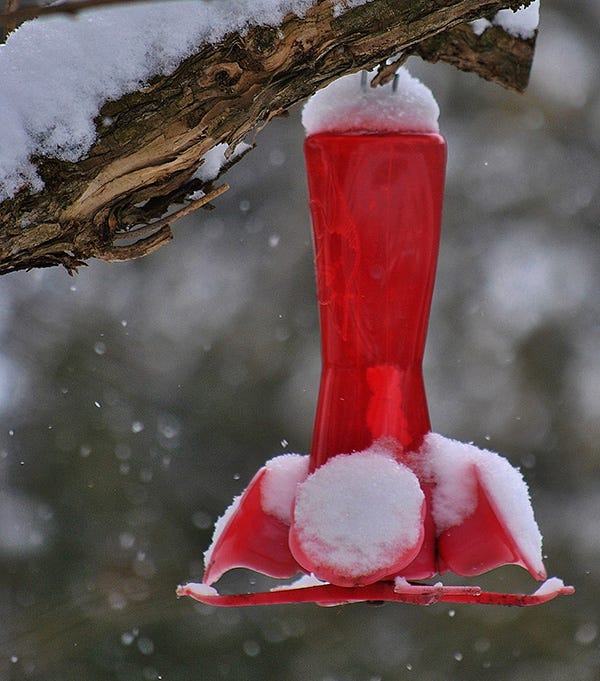 Some regions of the U.S. are lucky enough to have hummingbirds throughout the year. These areas, usually along the extreme southern borders, rarely get freezing weather which helps hummingbirds survive the winter.
Some regions of the U.S. are lucky enough to have hummingbirds throughout the year. These areas, usually along the extreme southern borders, rarely get freezing weather which helps hummingbirds survive the winter.
During normal weather in these areas, continue feeding your hummingbirds as normal. In fact, you may find that your hummingbirds become more reliant on your feeders as winter-blooming plants fade. With that in mind, it's extremely important to remain vigilant with your cleaning routines.
If truly cold weather sets in, be aware that your hummingbird friends are prepared for temperature extremes. When the air temperature gets too cold, hummingbirds will find a safe spot and enter a deep sleep called torpor which allows them to limit their energy use. Torpor is much like hibernation except that it only lasts a few hours. When they wake from torpor, they will be hungry so make sure your feeders are ice-free and full!
If snow settles on a hummingbird feeder, make sure to brush it off so hummingbirds can find feeder ports. Further, make sure the ports are ice and slush free since these areas are most likely to freeze first.
Of course, sometimes hummingbirds can get lost and end up much farther north than they intended to journey. If you spot a non-resident hummingbird at your winter hummingbird feeding station, place a heat lamp nearby and focus it on the feeder. This should help keep the nectar from freezing but also help warm up a bird that's not accustomed to such low temperatures.
Outdoor Winter Bird feeding Activities
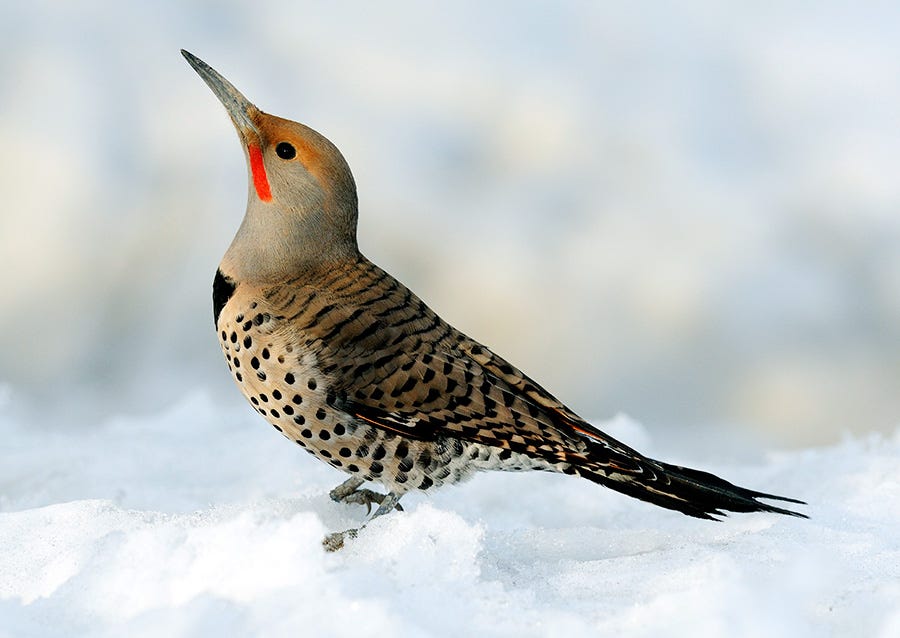
As a bird feeding enthusiast, you can't sit inside and watch your birds all day long. Bird feeders and waterers require a bit of maintenance, whether it's winter, spring, summer or fall.
In cold and wet weather, your feathered friends are likely to visit your feeders more often! That means you'll have plenty of things to do:
Refill feeders daily
Fill your feeders every day through the winter, but put out only a quantity of seed that the birds can eat before sundown. This is especially important where raccoons, bears, deer and other animals are a problem. By providing just enough for your birds, you're keeping those nocturnal visitors from recognizing a bird feeder as a useful food source.
Stamp snow down
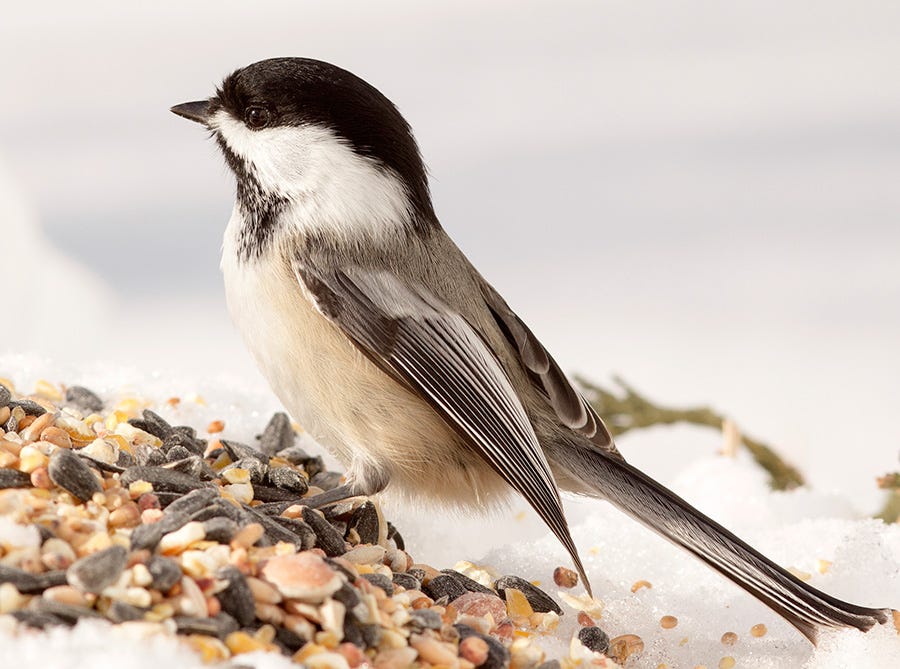 Many birds, including juncos and doves, don't feed directly from a feeder. Instead, they will eat underneath the feeder, where they snap up seeds that other birds have dropped. To help those birds, you should go out after a snow storm and stamp down the snow under the feeder. This helps these birds find seeds easier. You should also clean up discarded hulls regularly since removing debris gives your grass a chance to recover in the spring.
Many birds, including juncos and doves, don't feed directly from a feeder. Instead, they will eat underneath the feeder, where they snap up seeds that other birds have dropped. To help those birds, you should go out after a snow storm and stamp down the snow under the feeder. This helps these birds find seeds easier. You should also clean up discarded hulls regularly since removing debris gives your grass a chance to recover in the spring.
Break up ice
If you have a pond or other outdoor water feature, head out each morning and break up the layer of ice that may have formed over the water. Birds don't have the strength or weight to do this, and they need access to water on a daily basis. Be careful if you're trying to break the ice on a bird bath – the cold can weaken the bird bath and a sharp blow could cause it to break!
Refill water
While you should strive every day to keep the water in your birdbaths and waterers ice free, you also need to remember to change the water in these bird attractors. The water in a birdbath can get dirty from constant use. Even in the coldest months, the water in a bird waterer or bird bath can develop algae or bacteria.
Clean feeders
Whether it's summer, spring, fall or winter, a clean bird feeder is vital to birds! Dirty feeders can transfer disease and illnesses from bird to bird. Be sure to dump out any uneaten seeds and discarded hulls. Next, rinse the feeder off and scrub it with warm, soapy water. Regardless of the season or outside temperature, let it dry before putting it back in place and refilling with seeds.
Regional Bird Feeding & Migration
Since birds stick to certain ranges throughout the year, some regions of North America will see different birds throughout the winter. These birds may migrate from sub-arctic regions to the more temperate climates of the U.S. and Canada. Some birds stay in a region all year long. These birds are called "resident birds." Still, other birds may leave the continent for the winter.
Here's a quick look at which birds each region can expect:
| WINTER BIRD FEEDING GUIDE | ||
|---|---|---|
| Food | Quality | Information |
| U.S. Northeast | Mid October | Blue Jay, Dark-eyed Junco, Northern Cardinal |
| U.S. Atlantic Coast | Late November | Carolina Chickadee, Carolina Wren, Northern Cardinal |
| U.S. Southeast | Mid December | Carolina Wren, Fox Sparrow, White-throated Sparrow |
| U.S. Midwest | Late October | Dark-eyed Junco, Purple Finch, Red-breasted Nuthatch |
| U.S. Texas | Late December | American Goldfinch, Cedar Waxwing, Spotted Towhee |
| U.S. Rocky Mountains | Late September | American Goldfinch, Pine Siskin, White-breasted Nuthatch |
| U.S. Plains/Canada Plains | Late September | Black-capped Chickadee, Common Redpoll, Pinyon Jay |
| U.S. Southwest | January | Evening Grosbeak, Pyrrhuloxia, Western Scrub-Jay |
| U.S. Pacific Northwest/Canada B.C | Early November | Anna's Hummingbird, Golden-crowned Sparrow, Pine Siskin |
| U.S. Alaska | Late August | Boreal Chickadee, Common Redpoll, Gray Jay |
| Canada Ontario and Quebec | Early September | Blue Jay, Boreal Chickadee, Pine Siskin |
| Canada Maritimes | Late August | Common Redpoll, Purple finch, Red-breasted Nuthatch |
Your Winter Bird Feeding and Beyond
Remember, birds don't all disappear in the winter. If you put out bird seed, you'll be amazed at how many birds do stay around for the winter. Your bird feeders will be busy places — especially after snowstorms when trees and other food sources are covered.
It's also important to note that bird feeding is a year-round activity! Don't take your feeders down when the weather warms up or you may miss out on even more wonderful experiences.
Do you have questions about winter bird feeding? Visit us on Facebook. You can also subscribe to our newsletter to have exclusive updates and articles delivered to your inbox.
Source: https://www.perkypet.com/articles/winter-bird-feeding
Belum ada Komentar untuk "What Tempture Should You Fill Your Bird Feeds in Fallwinter North"
Posting Komentar